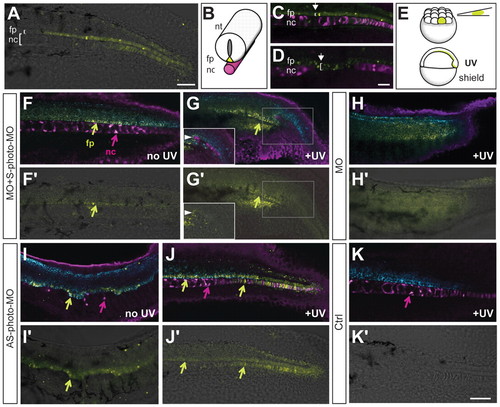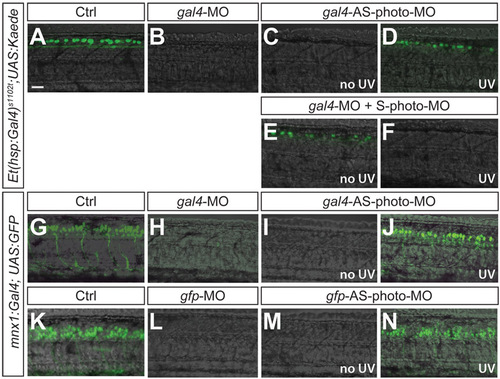- Title
-
Turning gene function ON and OFF using sense and antisense photo-morpholinos in zebrafish
- Authors
- Tallafuss, A., Gibson, D., Morcos, P., Li, Y., Seredick, S., Eisen, J., and Washbourne, P.
- Source
- Full text @ Development
|
S-photo-MO and AS-photo-MO regulate Ntla function. (A,B) Diagrams describing the mechanism of AS-photo-MO (A) and S-photo-MOs (B). (C) Molecular structure of the photo-subunit (red) and its position within the MO (green). (D,E) Lateral view of a wild-type embryo (D) and an ntla-MO injected embryo, missing posterior trunk and tail (E) at 48 hpf. Scale bar: 250 μm. (F-I) Overlays showing bright field and anti-Ntla labeling (green) in injected embryos at 26-28 hpf. Examples of severe (F), medium (G), mild (H) and normal (I) phenotypes. (J-L) Graphs showing percentage of embryos injected with MOs and photo-MOs resulting in severe (red), medium (orange), mild (light blue) and normal (dark blue) phenotypes, based on morphology. (J) ntla-S-photo-MOs of a length of 21 nucleotides (S21-photo-MO) and/or 25 nucleotides with four mismatches (S25-photo-MO) allow or block protein formation dependent on UV exposure. MO, n=60; MO UV, n=179; MO+S21-photo-MO, n=58; MO+S21-photo-MO UV, n=125; MO+S25-photo-MO, n=61; MO+S25-photo-MO UV, n=116; WT, n=114; WT UV, n=135. (K) All ntla-AS-photo-MO tested sufficiently block ntla gene function. Introducing two mismatches on either side of the photo-subunit (AS-4mis-photo-MO) significantly improved dissociation rate from the target and therefore recovery (P<0.05) of the phenotype after photo-cleavage compared with AS-photo-MO. AS-photo-MO, n=84; AS=photo=MO UV, n=132; AS-2mis-photo-MO, n=113; AS-2mis-photo-MO UV, n=134; AS-4mis-photo-MO, n=112; AS-4mis-photo-MO UV, n=152. Asterisks indicate significant differences (P<0.05) between untreated and UV-treated embryos. Student’s t-test includes data in groups ‘severe’ and ‘normal’. (L) Distribution of phenotypes after injecting different ratios of ntla-MO to S25-photo-MO solutions. The horizontal bar marks samples exposed to UV. (M) Quantification of in vitro mass spectroscopy analyses showing percentage of intensity of active (intact photo-element, red, pink) and inactive (cleaved photo-element, blue) ntla- or gfp-AS-photo-MOs, MO1 and MO2 respectively, measured over time after UV exposure. (N,O) Embryos injected with gfp-AS-photo-MO without UV exposure (N) and with UV exposure (O). Scale bar: 30 μm. |
|
Spatially restricted control of gene function using S- or AS-photo-MOs confirms ntla-dependent cell fate choice of MPCs. (A) Lateral view of live 28 hpf embryo highlighting notochord (nc) and floor plate (fp), created by a mosaic distribution of fluorescein-labeled control MO (yellow). (B) Cartoon showing neural tube (nt), fp (yellow) and underlying nc (magenta). (C,D) Distribution of fp cells (fluorescein, yellow) and Ntla antibody labeling in the notochord (magenta) in wild-type embryo (C) and ntla-MO-injected embryo lacking Ntla in some cells (arrow in D), leading to excess fp at the expense of notochord (compare extent of brackets). (E) Mosaic distribution of MO in non-neural tissues by injecting into one marginal cell of a 16-cell embryo. Embryos were exposed to UV at shield stage. (F-J2) Embryos show fluorescence (MO-fluorescein, yellow) in fp and/or notochord, Ntla (magenta) in notochord and zrf1 (cyan) staining in fp and neural tube. (G,G2) Inset in the bottom left corner shows a different z plane of the region marked by a gray box. Arrowheads point to the same Ntla-positive cell. (K,K2) Uninjected control embryo showing normal Ntla (magenta) and zrf1 (cyan) staining. (F-K2) Images show bright field and fluorescence labeling at 26-28 hpf. Embryos were injected with MO or photo-MOs as indicated and subjected to UV exposure as indicated (no UV, +UV). Scale bars: 30 μm for C,D; 50 μm for A,F-K2. |
|
Comparison of ubiquitous or cell-specific control of ntla gene function. (A) Embryos were injected with MOs at the one-cell stage. One group of embryos was exposed to light at 5 hpf, whereas in the other group, single cells within the MPCs were exposed to light at 11 hpf using a laser. (B) Normal Ntla protein distribution in embryos injected with gfp RNA as control. (C-I) Ntla labeling in transgenic embryos Tg(hsp70:Gal4-VP16, UAS:GFP) injected with MO or photo-MOs exposure as indicated. Embryos were treated with broad spectrum light (UV), kept in dark (no text) or exposed to laser (laser) as indicated. (F) Cells with photo-cleaved ntla-S-photo-MO lack Ntla labeling (arrow). Inset shows magnification of boxed area. Asterisks highlight Ntla expression in non-exposed cells. (I) Cells with photo-cleaved ntla-S-photo-MO show Ntla labeling, marked by asterisks. Inset shows magnification of boxed area. (J-K2) Embryos labeled for GFP (green) and Ntla (magenta) highlight cell fate of light exposed cells. J2 and K2 show higher magnifications of the boxed regions in J and K, respectively. (J2) Green arrow points to an fp cell (fluorescein, green). (K2) Green arrow indicates fluorescein labeling in cytosol and magenta arrow indicates Ntla labeling in the nucleus within cells in the nc. Scale bar: 50 μm. |
|
Temporal control of photo-cleavable morpholinos. (A,B) Percentage of embryos expressing fluorescent protein (FL; fluorescent, orange) compared with ‘non-glowers’ (no FL; non-fluorescent, blue). (A) Embryos injected with MOs targeting gal4 function and exposed to UV as indicated on the x-axis. WT, n=315; MO, n=179; MO+S-photo-MO, n=91; MO+S-photo-MO UV, n=99; AS-photo-MO, n=46; AS-photo-MO UV, n=90. (B) Embryos injected with MOs blocking GFP formation and exposed to UV as indicated on the x-axis. WT, n=144; MO, n=107; AS-photo-MO, n=106; AS-photo-MO UV, n=149. (C) Percentage of embryos with indicated pigment phenotype observed in sox10-MO injected embryos. MOs used and UV exposure are described on the x-axis. WT, n=81; MO, n=27; AS-photo-MO, n=58; AS-photo-MO 5hpf UV, n=44; AS-photo-MO 11hpf UV, n=48; AS-photo-MO 14hpf UV, n=35. Severe (red), no or only some pigment cells at 48 hpf; reduced (light blue), slightly diminished number of pigment cells compared with uninjected controls (normal, dark blue). (D-G2) Side view of two segments of Tg(mnx1:gal4,UAS:GFP) embryos at 26 hpf stained with anti-GFP (D-G, green), labeling all motoneurons or Alcama (D2-G2, magenta), labeling only SMNs in uninjected control embryo (D,D2), embryo injected with gal4-MO (E,E2) and embryo injected with gal4-MO/gal4-S-photo-MO (F,F2). (F) Embryos without UV exposure resemble normal GFP expression pattern. (G) GFP expression exclusively in PMNs in embryo exposed to UV at 14 hpf (G,G2). The image in G has been enhanced compared with F to improve visibility of PMN axons (see arrowheads). (H-J) High magnification of boxed regions in F (H) and G (I,J). (H,I) GFP-expressing neurons are not co-labeled with the SMN marker Alcama. (J) The margins of GFP-expressing neurons are labeled with Alcama. Arrowheads point to co-labeling of GFP (green) in the cytosol and Alcama (purple) in the membrane. (H-L) Asterisks indicate PMN cell bodies. (K,L) Live images of embryos without (K) and with (L) UV exposure. Location and axon trajectory identify GFP-expressing neurons as motoneurons. White arrowheads mark ventral projections, yellow arrowheads mark dorsal projections. Asterisks mark PMNs. (M-T) Embryos injected with sox10-MO (N-T) and uninjected control embryo (M). (M-P,S,T) Lateral views of three to four hemisegments in Tg(3.1neurog1:GFP) embryos expressing GFP in dorsal Rohon-Beard neurons and laterally located DRG neurons (arrowheads) at 3 dpf. Severely reduced number of DRG neurons in sox10-MO injected embryo (N) and sox10-AS-photo-MO injected embryo without UV exposure (O) compared with control embryo (M). UV exposure at 5 hpf leads to normal DRG development (P). UV exposure at 11 hpf leads to partial recovery of DRG formation (S), UV exposure at 14 hpf leads to severe reduction of DRG neurons (T). (Q,R) Severe reduction in pigment cells in sox10-MO injected embryo (R) compared with control embryo (Q), shown at 3 dpf. Scale bars: 30 μm for D-G2,M-P,S,T; 7.5 μm for H-J; 15 μm for K,L; 300 μm for Q,R. |
|
Time course showing cleavage of the photo-element and in vivo time line. (A) Examples of mass spectroscopy reads obtained after in vitro UV exposure of gfp-AS-photo-MO at 0, 15 and 120 seconds, showing complete cleavage of the photo-element after 2 minutes. (B-I) In vivo time course showing onset of fluorescent protein expression in Tg(mnx1:Gal4-VP16,UAS:GFP) embryo exposed to 5 minutes UV using gal4-MO (C,G), gal4-AS-photo-MO (D,H) and gfp-AS-photo-MO (E,I). (C,D) No fluorescent signal in gal4-MO (C) and gal4-AS-photo-MO (D) injected embryos but signal in gfp-AS-photo-MO injected embryos (E) 1 hour after UV exposure. (H) Fluorescent signal in gal4-AS-photo-MO injected embryos 2 hours after UV exposure. Scale bar: 50 μm. |
|
GFP-expression in embryos injected with gal4- or gfp-MOs. (A-F) Lateral view of Et(-1.5hsp70l:Gal4-VP16)s1102t,(UAS-E1b:Kaede)s1999t embryos at 26 hpf injected with gal4-MO. No GFP expression is seen in a Gal4-MO-injected embryo (B) whereas control embryo (A) shows GFP expression in dorsally located Rohon-Beard neurons. (C) gal4-AS-photo-MO without UV blocks GFP expression. (D) Normal GFP expression in embryo exposed to UV at 30% epiboly. (E) gal4-MO/gal4-S-photo-MO leads to normal GFP expression. (F) After UV at 30% epiboly exposure GFP expression is absent. (G-N) Lateral views of Tg(mnx1:gal4, UAS:GFP) embryo at 26 hpf. (G) GFP expression in motoneurons in control embryos. (H,L) GFP expression is blocked in gal4-MO (H) and gfp-MO (L) injected embryos as well as in gal4-AS-photo-MO (I) and gfp-AS-photo-MO (M) injected embryos without UV exposure. (J,N) Restored GFP expression in embryos exposed to UV at 30% epiboly. Scale bar: 30 μm. |






